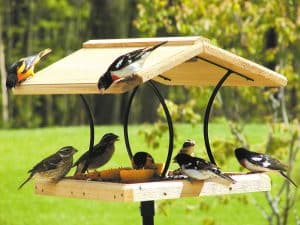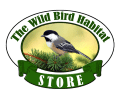Blog - General
SUMMER BIRD FEEDING
Published by the Wild Bird Habitat Stores of Nebraska
Summer is a time when many folks who maintain bird feeders during the winter continue providing supplemental food sources for our backyard birds during the summer. They are often rewarded by young cardinals, woodpeckers, chickadees and other fledglings brought to the bird feeder by their parents. Most natural foods have become scarce after the long winter and won’t be replenished until those food sources are regenerated during the summer’s growing season. Nesting birds require a vast amount of energy and those supplemental food sources provided at backyard bird feeders can be a welcoming treat.
Feeding birds in our backyards has become more than just a passing hobby. In fact, backyard bird feeding, and birding in general, has become the fastest growing outdoor recreational activity for families and individuals in the United States, with close ties to gardening. Birds entertain us, they educate us, and they provide a natural form of insect control in our yards and gardens. Watching birds also provides a form of comfort and relaxation reducing stress and anxiety from our busy lives. But what does it take to feed birds and attract them to our yards? It’s very simple. Birds find food by sight. You put the food out and they will come.
In days past many people would just scatter the bird seed on the ground or possibly had a single bird feeder filled with a general wild bird economy mix and expected all birds to enjoy their fill. However, backyard bird feeding has become more specialized by targeting the specific feeding habits of birds to meet their needs. Some birds will only feed at elevated levels like the chickadees, House Finch and the American Goldfinch. Mourning Doves, Towhees, and an assortment of native sparrows feed primarily on the ground. Yet other birds such as woodpeckers and nuthatches prefer to feed around the tree trunk zone. Then there are the Northern Cardinals and Blue Jays, who are just plain opportunistic and will feed wherever the wild bird feed you provide is accessible to them.
Two of the most common styles of bird feeders for attracting a large variety of birds are hopper feeders, which will attract large and small birds, and seed tube bird feeders designed primarily for smaller birds. Other bird feeders include ground and platform bird feeders which are undoubtedly the most versatile for attracting many bird species and Nyjer thistle feeders for attracting members of the finch family. Suet and peanut feeders target woodpeckers, nuthatches, chickadees and Carolina Wrens. These seven types of bird feeders are recommended for a basic backyard bird feeding program to attract the largest diversity of birds to your yard.
Then there are those bird feeders that are more seasonal and used to attract a specific species of summer birds. These include hummingbird feeders, oriole feeders, and bluebird feeders. It is exciting to see orioles that have traveled thousands of miles from the Tropics to your backyard to feed and raise their family.
Just as the type of bird feeder you select determines which birds you will attract, the bird seed you fill them with is just as important. Birds that feed at elevated bird feeders prefer sunflower seed, safflower seed, and other nut-based mixes. If you put a general wild bird mix in these feeders, they will sweep through it picking out the nut products, scattering everything else to the ground.
Thistle feeders are for Nyjer thistle seed and finch mixes. Caution must be taken to assure the thistle seed is fresh or the finch you are trying to attract will reject it. A good finch mix contains only thistle seed and finely ground sunflower chips. Avoid those finch mixes with other so-called filler seeds. Many commercial finch mixes contain canary reed grass seed which is an invasive species of grass.
General wild bird mixes have a base of white Proso millet with cracked corn, peanuts, and sunflower seeds added. They are best used on platform and ground feeders where birds can select the seed they want without sweeping through it. However, when purchasing a wild bird mix read the label. Many inexpensive general wild bird mixes contain filler seeds such as Milo, wheat, red millet along with other cereal grains and weed seed products that birds do not eat. As much as 40% of a bag of bird seed that contains these filler seeds can end up uneaten and wasted on the ground. There is a variety of no-waste and no-mess wild bird feeds offered at Wild Bird Habitat. Although they may cost a little more, it will save you money in the long run yet attracts all your favorite birds.
If squirrels and Common Grackles (blackbirds) are robbing the seed you intended for your favorite birds to enjoy, you may want to consider using white safflower seed, or Nutra (brown) safflower seed. Squirrels will leave it alone and the blackbirds are not very fond of it. Nutra safflower seed will attract all your favorite backyard birds and can be used in any type of bird feeder. Other good options include caged bird feeders, squirrel proof bird feeders, or adding a baffle to keep the squirrels at bay.
And don’t forget to add a bird bath to your backyard bird feeding program. Fresh clean water is essential for birds. You may be surprised at what birds stop by for a drink. You might be treated to Cedar waxwings, Yellow Warblers, or bluebirds drinking and bathing during hot summer days. Remember to keep your bird bath in a shady area as sun promotes algae growth.
Finally, consider planting some habitat in your yard. All living things on our planet require food, water, and shelter. Hedges and shrubs will not only offer protection from bitter winter winds, but a place for birds to nest and provide a natural food source. Consult with a master gardener at your local nursery or the Nebraska Cooperative Extension Office about planting habitat for wildlife. Follow these tips from the Wild Bird Habitat Store, then sit back and enjoy a backyard filled with your feathered friends.
Lincoln’s Wild Bird Habitat Stores opened on October 1st, 1993, and were honored in 2015 to be awarded “Best Bird Feeding Retailer” in the U.S. by leaders in the Bird Feeding Industry. Many bird feeders and bird feeding supplies at Wild Bird Habitat are manufactured in America and come with a warranty.
